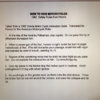RRR OM, ES TNS FER YER QSL. YR SIG HR 469 ES TNX FER RPT. SK WX6RST
Did you understand that? I learned to translate that when i was 12. I did NOT learn to translate WAN, AP, SSID, Ethernet, LAN, at that point in time (because it was 60 years ago).
Do you all understand that using shorthand that YOU consider child's play is totally confusing to those of us who are not cognoscenti to the lingo?
I have a CAT-5 cable full of data in my left hand. I am in my engineering lab about 100 meters away from the house. I need to connect that CAT 5 cable to a box that broadcasts that data all over my lab. I need something in the house that hears that data and rebroadcasts it throughout the house.
Nobody is doing terabyte downloads, nor gigabyte files. We are simply trying to run a small home business between my lab and the house. That OUGHT to be child's play for this connected universe, and yet the high priests of the connected world have conspired to make it damned difficult to do.
Did I explain the problem succinctly?
ROG OM?
Jim
Assuming some sort of Internet connection that doesn't require a login (almost all cable and most satellite providers), to get the router to provide Internet to your lab requires that you connect the modem to the WAN port on the router using an Ethernet cable.
The WAN port on the router will be marked "WAN" or "Internet." It
probably will be a different color from the other ports. Most (but not all) Netgear routers use black for the LAN ports and yellow for the WAN port. But there are exceptions.
Whatever the color scheme, connect an Ethernet cable from the modem to the router's WAN port. Don't plug the router into the AC power just yet. Instead,
unplug the modem from the AC power and let it sit for a while. 15 or 20 seconds should be enough. Then plug it back in and wait for two or three minutes.
Next, plug the router into the AC power and wait for two or three minutes.
Turn the router upside-down and look for a label. Most Netgear routers have them. Among the information on that label should be a line labeled "WiFi Network Name (SSID)" or something quite similar. That is the router's default WiFi Network Name (SSID). Write it down. Another line should be labeled "Network Key (Password)" or something quite similar. Write that down, too.
If you like, you can also use your phone to take a picture of the label.
Each device you wish to connect to the WiFi network will have its own interface design for connecting to a WiFi network. Here are some possibilities:
A little antenna symbol is a common icon.
Radio waves radiating from the corner of a square box is another.
A circle or segment of a circle with an arrow or a triangle pointing outward from the center of the circle is yet another.
To connect a computer to the WiFi network, move the mouse around near where the clock is and look for some icon that appears to have something to do with radio waves. When you find one, hold the mouse over it and see if anything happens. If not, then click it and see if something happens.
At some point, you should get a dialogue box asking you if you want to connect to a wireless network. There may be several choices. Choose the one that you wrote down from the label on the bottom of the router. It should be one of the choices and the strongest one.
Next, when it asks for the key or password, enter the one you wrote down from the label on the bottom of the router.
If there is a box for "Connect Automatically," "Store this Connection," "Remember this Network," or some other language suggesting that the device is willing to remember it for future use, check that box.
Then click "Apply," "Connect," or whatever other button suggests that you are saying "Yes, I would like to connect to this network."
You will have to do some semblance of the above for every device you want to connect to the WiFi network.
As for extending the Lab's connection to your house, that's probably not possible using the equipment you have. 100 meters from a consumer-grade router is theoretically possible outdoors, but unlikely to provide a stable, usable signal in the real world. It can be done using outdoor equipment of various sorts, but it's unlikely that what you have will work for what you want to do.
Rich




